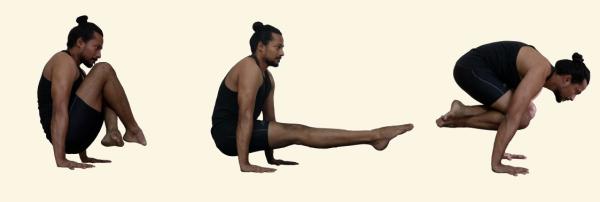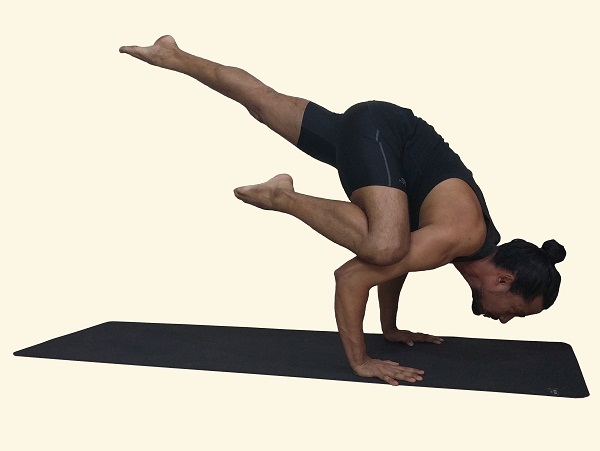Eka = One, Pad = Foot or Leg , Bak = Crane.
This is an advanced pose that can only be done once you have mastered Kakasana and Bakasana, it requires a lot of balance and practice. If you are learning about this posture then we assume that you already know about proper hand placement and alignment for arm balancing postures.
This posture requires a very strong core, forearms, and shoulders. Because this posture is asymmetric you need to be careful about doing it so as not to create any imbalances.
To prepare the core for this posture practice the following postures- Tolasana, Brahmcharyasana (L-sit), and Lolasana (see photo below).

Ek pada bakasana (One legged crane) progression – You might not be able to get into this posture on your first try, so let’s discuss how you can train for this posture step by step.
- Because this posture is asymmetric so we need to learn to shift the weight on each hand. To practice, get into either the Kakasana (crow pose) or the Bakasana (crane pose) and start to shift (more) weight from one hand to the other.
- The next practice would be to shift the weight more on one side and try to lift the knee of the other side slightly above the upper arm. So if you are putting more weight on your left hand then you lift your right knee slightly above the right upper arm and vice versa.
- Next work on moving your knee which is off away from your core, do it in steps and only move to a point where you can balance.
- This part is the most difficult. Here you are working on straightening one of your legs and at the same time, you have to shift your body slightly forward. (remember gravity is always working, to balance, equal weight should be in the forward and the backward direction). In the final position imagine you are lengthening your whole body from the head to the toe.

Steps– If you are adding this posture to your Yoga flow then you can add the following alignment cues.
- Come into Kakasana.
- Once you’re stable in your Kakasana, shift more weight on your left hand.
- Inhale, hold your breath, lift your right knee slightly above the right upper arm and squeeze it closer toward your midline.
- With a strong and controlled exhale start shifting more weight on the left arm and move your upper body slightly forward, at the same time work on straightening your right leg. It’s important that this action happens at the same time. If the timing is off then you will not be able to balance.
- Hold for as long as you can (work on making the breaths smooth and long), initially, it will be for a few seconds, slowly build up. Come back down to the squatting position and repeat on the other side.
Benefits
- Strengthens the core muscles
- Strengthens wrists, arms, back, shoulders
- It is an asymmetrical posture that requires a lot of strength, so it improves the coordination of all the muscles.
Contraindications/ Precautions
- Back problems, slipped disc, disc prolapse.
- Neck injury.
- Wrist injury.
Looking for more arm baling postures? Check our arm balancing posture library.